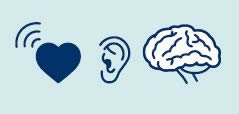Through cultivated ears…
Mostly when we think of music, we think of listening to it. We think of music we like and don’t like; music that settles us down or pumps us up. This way of being affected by music is known as a “learned cognitive response.” It has a cultural component, but there’s no doubt the groundwork is laid in the womb. A baby hears a mother’s heartbeat, and learns early on that there’s a connection between arousal and an increased rhythmic pulse. Hormone release, oxygenation and mood can all be affected.
The back roads of our minds…
Alzheimer’s patients, who can’t recognize their own children, can sometimes remember and sing along to hymns they learned as kids. People who stutter in normal conversation can sometimes sing seamlessly. Music, it appears, offers a secondary route within the brain, accessing language and memory areas using back roads, when the primary route is blocked.
The beat goes in…
Ever find yourself tapping in time to the music? Walking in step with an industrial hammer? Rhythms like these can drive neural firing, a process sometimes called “entrainment.” Once captured by the rhythm, it can potentially alter our brainwaves.
Our cells listen, too…
The human body has several receptors sensitive to sound: auditory hairs in our ears, mechanoreceptors in our skin and sound-interested neurons scattered throughout our brains. All of these areas need more study, but a growing field is vibroacoustic therapy, where low-frequency sound is applied to the body in order to heal it.






